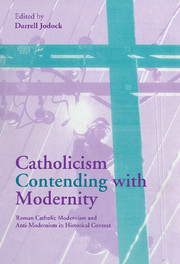 Catholicism Contending with Modernity
Catholicism Contending with Modernity Book contents
- Frontmatter
- Contents
- List of contributors
- Acknowledgments
- List of abbreviations
- Note on the text
- Introduction I: The Modernist crisis
- Introduction II: The Modernists and the anti-Modernists
- PART I THE LATE NINETEENTH-CENTURY SETTING OF MODERNISM AND ANTI-MODERNISM
- PART II MAURICE BLONDEL AND ALFRED LOISY IN FRANCE
- PART III FRIEDRICH VON HÜGEL AND MAUDE PETRE IN ENGLAND
- PART IV SOCIAL MODERNISM AND ANTI-MODERNISM IN FRANCE
- Conclusion
- Index
Introduction I: The Modernist crisis
Published online by Cambridge University Press: 30 October 2009
- Frontmatter
- Contents
- List of contributors
- Acknowledgments
- List of abbreviations
- Note on the text
- Introduction I: The Modernist crisis
- Introduction II: The Modernists and the anti-Modernists
- PART I THE LATE NINETEENTH-CENTURY SETTING OF MODERNISM AND ANTI-MODERNISM
- PART II MAURICE BLONDEL AND ALFRED LOISY IN FRANCE
- PART III FRIEDRICH VON HÜGEL AND MAUDE PETRE IN ENGLAND
- PART IV SOCIAL MODERNISM AND ANTI-MODERNISM IN FRANCE
- Conclusion
- Index
Summary
On 8 September 1907 Pope Pius X issued Pascendi dominici gregis, an encyclical in which he condemned “Modernism” as the “synthesis of all heresies.” The Modernists, he said, “lay the axe not to the branches and shoots, but to the very root, that is, to the faith and its deepest fires … so that there is no part of Catholic truth from which they hold their hand, none that they do not strive to corrupt.” In the pope's mind the Modernists posed a threat to the church that was all the more dangerous because “the partisans of error are to be sought not only among the Church's open enemies; they lie hid, a thing to be deeply deplored and feared, in her very bosom and heart.” In Pascendi this “Modernism” was defined in such an encompassing way, those labeled “Modernists” were condemned with such vehemence, and the measures prescribed to prevent its growth were so stringent that it virtually slammed the door on any historical study of the Bible, on theological creativity, and on church reform. The door would remain closed for the next three decades. Its consequences were serious and far-reaching.
What kind of perceived threat elicited this response? Who were the Modernists and what did they advocate? And what was the origin of the anti-Modernism that reached full expression in this encyclical? These questions, and others like them, will occupy this entire volume.
- Type
- Chapter
- Information
- Catholicism Contending with ModernityRoman Catholic Modernism and Anti-Modernism in Historical Context, pp. 1 - 19Publisher: Cambridge University PressPrint publication year: 2000


